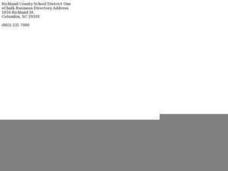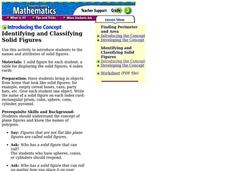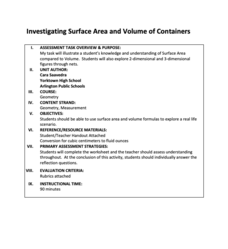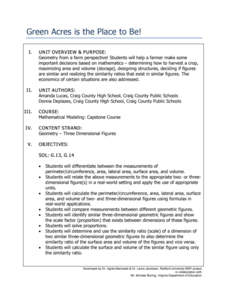Annenberg Foundation
Geometry 3D Shapes: Euler's Theorem
How do you get a theorem named after you? Euler knows what it takes! The third lesson of five asks pupils to use an interactive activity to compare the faces, vertices, and edges of seven different three-dimensional solids. They use...
Shodor Education Foundation
Cross Section Flyer
Scholars see cross sections come to life using an app to investigate cross sections of three-dimensional solids. They look at prisms, pyramids, cylinders, cones, and double cones.
Curated OER
Investigating Shapes in Our World
First graders explore shapes. In this geometry lesson, 1st graders make shapes with geo-boards, use play-dough to make three-dimensional figures, and make a shape book using pre-cut shapes.
Denton Independent School District
Build a Geome-Tree
Geometers construct a mobile or ornament using nets of three-dimensional polyhedrons. Not only do they need to compute the volume and surface area of each figure, they also earn points for creativity, neatness, and more!
Curated OER
Using 2 and 3 Dimensional Geometric Shapes
Students explore geometry by participating in a shape identification activity. In this figure dimensions lesson, students identify the difference between 2 and 3 dimensional shapes by their vertices and faces. Students examine blocks in...
Curated OER
Three Dimensional Geometry Crossword
In this three dimensional geometry crossword, students explore terminology in fifteen crossword problems. A word bank and solutions are provided.
Curated OER
Seeing in 3D: Interpreting Two-Dimensional Diagrams of Three-Dimensional Objects
Students hone in on their skills at reading diagrams. In this dimensional lesson students collect information on the functions of organs then figure out how all the parts work together.
Curated OER
Measurement: 2D and 3D
Students solve volume problems. In this geometry lesson, the class watches a video about clean water (link provided) and individuals compare the volume of different prisms, including an actual drinking glass. Extension activities include...
K-5 Math Teaching Resources
Number Cube
Building a six-sided number cube has never been so easy. Just cut out the figure on the solid lines, fold on the dotted lines, connect the sides together using glue or tape, and there you have it!
Corbett Maths
3D Pythagoras
Calculate one hypotenuse then repeat. The resource provides a variety of ways for finding the length of the diagonal in a prism. Using the Pythagorean Theorem, pupils find a variety of distances in 3-D figures. The distances range from...
Curated OER
Geometry Vases: Ceramics Lesson
Geometric shapes are used in math and in art. Learners discuss the various names, dimensions, and attributes of geometric shapes, then apply that knowledge to design a vase. They use 3-D shapes to make a cubist-style vase out of clay.
Curated OER
Three-dimensional Shapes
In this three-dimensional shapes worksheet, 6th graders identify and complete 4 different questions that include various types of three-dimensional shapes. First, they identify the shape illustrated as it relates to a cube. Then,...
Curated OER
Countdown Challenge: Platonic Solids - Part I
Use a Platonic solids worksheet to record the number of faces, edges, and vertices of five polyhedra whose faces, edges, and vertices are all identical. For each figure, learners write a proof of Euler's formula (F+V=E+2). They create a...
Curated OER
Prisms, Pyramids, and Nets
Students compare and contrast the characteristics of prisms and pyramids. In groups, they are given different colored construction paper to make rectanglar prisms. They identify the shapes of the faces and record the number of faces,...
Curated OER
Drawing Figures
Third graders draw shapes that are congruent. In this congruency instructional activity, 3rd graders use grid paper to draw letters and figures and their congruent partners. They complete a worksheet while working in a whole class...
Curated OER
Volume of Solids: Algebra/Geometry Institute
Use this volume of solids lesson to have learners find the surface area and volume of cylinders, pyramids, and prisms. They place cubes inside three-dimensional figures to determine the volume. Worksheets and answers are provided.
Curated OER
2-Dimensional Shapes: Drawing Shapes
Some of the best practice with shape identification comes from drawing the figures first-hand. Young geometers draw nine two-dimensional shapes: rectangle, circle, square, pentagon, hexagon, octagon, triangle with three equal sides,...
Curated OER
Naming 2-Dimensional Shapes
Inside each of these two-dimensional shapes, scholars identify the figure by writing its name. There is a word bank for them to work from, but some shape names are used multiple times. There are six identifiers they use: pentagon,...
Curated OER
Identifying and Classifying Solid Figures
Learners identify and classify solid geometric figures. In this geometry lesson, students bring in objects that look like solid shapes and identify their attributes. Learners identify the number of surfaces and faces on each figure.
J. Paul Getty Trust
Expressing Emotions through Art Lesson 3—Everybody Works Together
See how art can communicate the idea of working together with your class. They will view art and describe space, color, shape, and lines in art. Then they will overlap in their art to show a sense of space. In the end, they will be able...
Radford University
Lemonade Business - Investigating Surface Area and Volume of Containers
Boost lemonade sales by using the perfect container. For a given volume, future entrepreneurs design a container that will have the least surface area and by extension, the least cost of material. They create a two-dimensional net of...
Radford University
Green Acres is the Place to Be!
Nurture a love of math and farming at the same time. Pupils apply geometry concepts, such as surface area and volume of three-dimensional shapes and similarity ratios, to farming contexts. They consider the dimensions of bales of hay,...
Radford University
Coal Silo Design Task
The coal is mined. Now what? Scholars design a coal silo that stores mined earth using at least two different three-dimensional shapes. They calculate the volume, determine the amount of mined earth produced in a day, and find the amount...
Charleston School District
3D Applications of the Pythagorean Theorem
How many right triangles can you find in a prism, cone, or pyramid? Using right triangles to find lengths in three-dimensional figures is the focus of the lesson. After working with the Pythagorean Theorem to find missing side lengths...
Other popular searches
- Three Dimensional Figures
- Three Dimensional Figures
- Nets 3 Dimensional Figures
- 2 and 3 Dimensional Figures
- Graph 3 Dimensional Figures
- And 3 Dimensional Figures
- Draw 3 Dimensional Figures
- 3 Dimensional Figures Net
- Making 3 Dimensional Figures

























